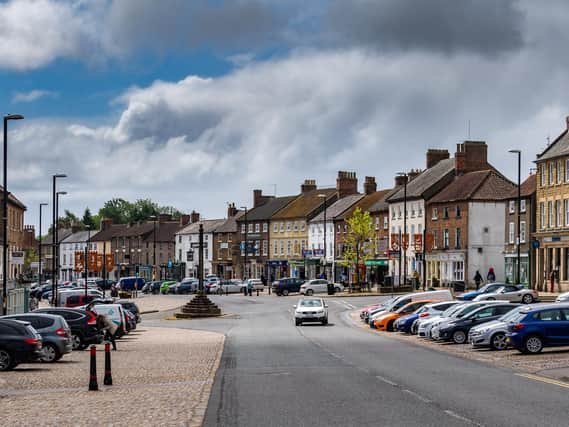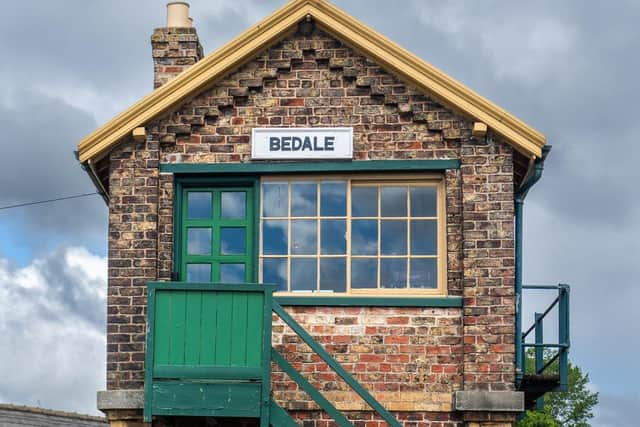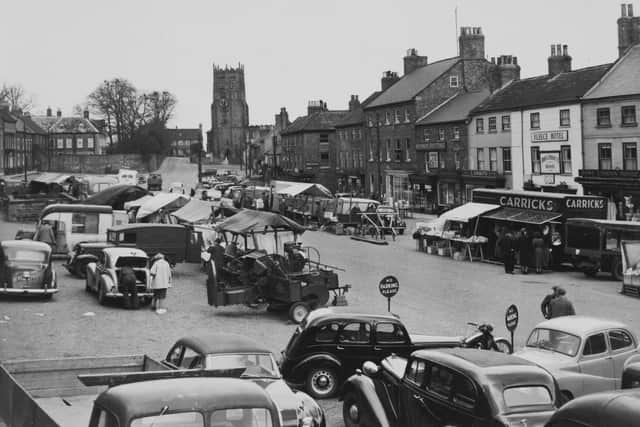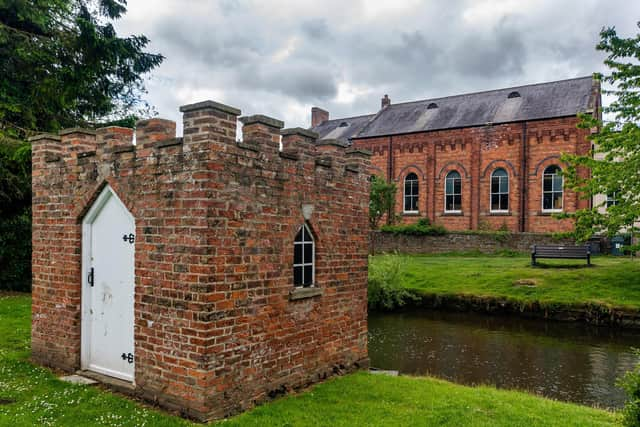From Romans and Vikings to conjurers and film stars - Bedale has quite a story to tell


No-one remembers why it was that Bedale was picked as a location for one of our best-loved period dramas, but in 1945 (just as the war was drawing to an end) the place was buzzing with the arrival of the cast and crew of The Way to the Stars.
Big names billeted hereabouts included John Mills, Michael Redgrave, Douglass Montgomery and Stanley Holloway. The story is set at a fictional airbase and in a nearby town, where the men go for their rest and recuperation. Terence Rattigan’s play Flare Path was the inspiration for the movie, and either he – or someone connected with the production team – must have visited Bedale at some point and remembered that it would provide an ideal backdrop for the action.
Advertisement
Hide AdAdvertisement
Hide AdThe significance of the decision to film in this part of Yorkshire is that at the time it was unusual for films to leave the studios in and around London, and film anywhere other than places like Elstree, Pinewood, Denham and Shepperton. If you wanted a rural setting, with a fine market cross, you physically built it on the back lot, or perhaps in the studio hangar.


The Way to the Stars is almost completely “natural” and only a little of it was filmed outside our county. Watching it today, it is interesting to spot where the cameras were placed and the angles they used.
Back then Mills and the cast would, just like visitors today, have found much to enjoy in charmingly picturesque Bedale.
The team would probably have arrived by rail, on the branch line from Northallerton. That closed in 1954, after almost a century of use. Happily it is now part of the popular heritage Wensleydale Railway, which runs between Leeming Bar and Redmire.
Advertisement
Hide AdAdvertisement
Hide AdThen as now, they might have strolled down the road and over Bedale Beck, a tributary of the River Swale. The Beck throughout history has played an important part in the life of the area, supporting several watermills. At one point, there were extensive plans to turn it into a navigable stretch of water that would allow barges into a large dock basin. That plan was abandoned with the coming of the railway in 1855.


The Anglo-Saxon church in Bedale was mentioned in the Domesday Book, but much of the present building dates from the 12th century. This is the beautiful St Gregory’s, a Grade I listed building, which boasts the oldest ringable bell in the country, installed in 1360.
It was named after St Gregory the Great (Bishop of Rome), known for organising the first large-scale mission to convert the then pagan Anglo-Saxons to Christianity, and here in Bedale we have one of the very first toeholds of the “new” religion.
The Vikings may also have left their mark. In 2012, a group of metal detectorists stumbled upon a hoard of treasure in Bedale that had – perhaps – been looted from the locals by some Scandinavian marauders and then quickly hidden. Experts at the Yorkshire Museum in York, where the hoard is now on view, say there are numerous theories revolving around the 48 gold and silver items but the true story may never be known.
Advertisement
Hide AdAdvertisement
Hide AdWhat is known is the pieces all date from the 9th and 10th centuries, when England was on the brink of becoming one kingdom. The detectorists found ingots, necklaces, arm bands and a magnificent sword pommel.


Even after the Vikings had gone, the threat from marauding Scots remained for many centuries and the church was a fortified point of refuge for the locals.
What many who admire these lovely surroundings perhaps don’t realise is that they would do well to look down at the floor in front of the altar. They are standing on the last resting place of one of the most remarkable showmen of Georgian Britain, a man whose surname is still revered by many members of the illustrious and internationally famous Magic Circle.
The man in question has lain there, under the chancel, since 1799. The Rector who officiated at the funeral service was the Rev Thomas Monson. Two centuries later one of his successors, David Paton-Williams, became intrigued by the stone that he walked over every day.
Advertisement
Hide AdAdvertisement
Hide Ad“The inscription is so worn that you really can’t make out anything at all,” he recalls. “But, intriguingly, there is a decoration of fossils and shells all around the edge. Why did someone choose that? I’m a naturally curious sort of man so I began to start digging around in local records.”
He subsequently discovered he had found the last resting place of Christian William Anthony Katterfelto – otherwise known as Gustavus Katterfelto, a conjurer, lecturer and quack.
Paton-Williams, now Rector of St Columba’s in Edinburgh, spent many hours researching the life of the man and this became a book, which charts the rise (and sad fall) of someone whose powers of self-promotion earned him the title of ‘The Prince of Puff’.
“The more I dug, the more I discovered and I filled up many notebooks of research. Why did the people of Bedale allow this stranger to be buried in their church? Because he’d been there before, and they had total faith in what he told them.
Advertisement
Hide AdAdvertisement
Hide Ad“They believed that a great philosopher and man of science was in their midst and that he had honoured them with his illustrious presence. He had entertained them, and his performance had been both revelatory and instructional.”
So when he died it was their turn to honour him. His death notice turned up in the York Chronicle a few days later. The obituary writer described him as “the wonderful philosopher, Dr Katterfelto” and his passing also warranted mention in one of London’s society magazines of the day.
This intriguing figure arrived in Hull in 1776, having travelled from Europe, and with him was his heavily pregnant wife, Martha, and a small daughter. He was also accompanied by a whole cartload of boxes. His mission was to educate the inhabitants of every community he visited.
He made grandiose claims and informed people that his lectures and “surprising” experiments were “Philosophical, Mathematical, Optical, Electrical, Physical, Chemical, Pneumatic, Hydraulic, Perotic, Hydrostatic, Stenographic, Pollengestic and Caprimandic Arts”.
Advertisement
Hide AdAdvertisement
Hide Ad“It’s quite a list,” says Paton-Williams, “although some of the words defy definition. No wonder that he went on to have a glittering career in London and then in towns and cities across the UK.”
Despite the intrigue around him he returned to North Yorkshire nearly penniless. “He must have felt that it was a place he could call ‘home’. What’s that lovely line about ‘the kindness of strangers’? Bedale is a very embracing sort of place.”
There is also much more to this attractive market town with its cobbled square than meets the eye.
It is home to a petting zoo, a brass band, the last remaining Leech House, where Georgian apothecaries would pick up the creatures for medicinal use, not to mention an early 14th century market cross and the stunning gardens at the nearby Thorp Perrow Arboretum. And we haven’t even talked about the cheese shops…
Advertisement
Hide AdAdvertisement
Hide AdEditor’s note: first and foremost - and rarely have I written down these words with more sincerity - I hope this finds you well.
Almost certainly you are here because you value the quality and the integrity of the journalism produced by The Yorkshire Post’s journalists - almost all of which live alongside you in Yorkshire, spending the wages they earn with Yorkshire businesses - who last year took this title to the industry watchdog’s Most Trusted Newspaper in Britain accolade.
And that is why I must make an urgent request of you: as advertising revenue declines, your support becomes evermore crucial to the maintenance of the journalistic standards expected of The Yorkshire Post. If you can, safely, please buy a paper or take up a subscription. We want to continue to make you proud of Yorkshire’s National Newspaper but we are going to need your help.
Postal subscription copies can be ordered by calling 0330 4030066 or by emailing [email protected]. Vouchers, to be exchanged at retail sales outlets - our newsagents need you, too - can be subscribed to by contacting subscriptions on 0330 1235950 or by visiting www.localsubsplus.co.uk where you should select The Yorkshire Post from the list of titles available.
Advertisement
Hide AdAdvertisement
Hide AdIf you want to help right now, download our tablet app from the App / Play Stores. Every contribution you make helps to provide this county with the best regional journalism in the country.
Sincerely. Thank you.
James Mitchinson
Editor